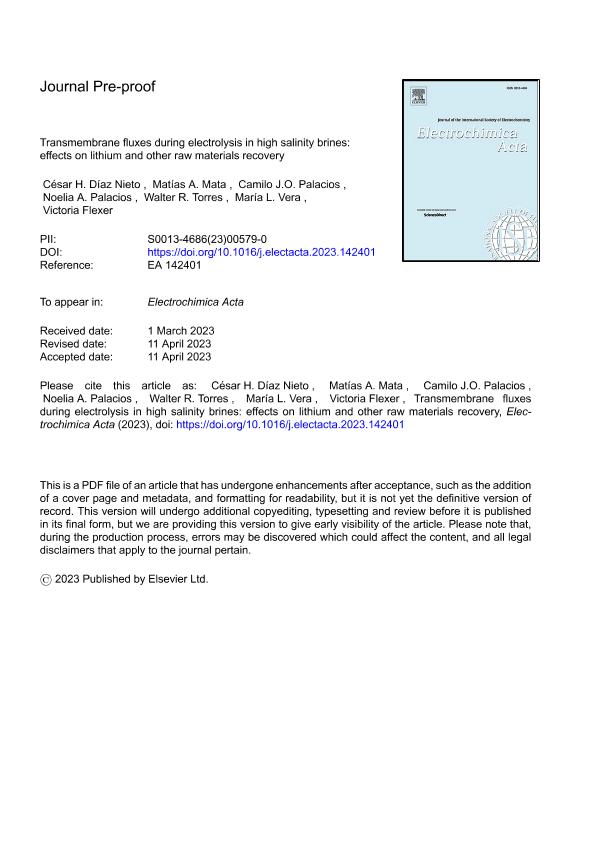Artículo
Transmembrane fluxes during electrolysis in high salinity brines: Effects on lithium and other raw materials recovery
Díaz Nieto, César Horacio ; Mata, Matías Armando
; Mata, Matías Armando ; Palacios, Camilo Javier Oscar
; Palacios, Camilo Javier Oscar ; Palacios, Noelia Anahí
; Palacios, Noelia Anahí ; Torres, Walter Ramon
; Torres, Walter Ramon ; Vera, Maria Laura
; Vera, Maria Laura ; Flexer, Victoria
; Flexer, Victoria
 ; Mata, Matías Armando
; Mata, Matías Armando ; Palacios, Camilo Javier Oscar
; Palacios, Camilo Javier Oscar ; Palacios, Noelia Anahí
; Palacios, Noelia Anahí ; Torres, Walter Ramon
; Torres, Walter Ramon ; Vera, Maria Laura
; Vera, Maria Laura ; Flexer, Victoria
; Flexer, Victoria
Fecha de publicación:
06/2023
Editorial:
Pergamon-Elsevier Science Ltd
Revista:
Electrochimica Acta
ISSN:
0013-4686
Idioma:
Inglés
Tipo de recurso:
Artículo publicado
Clasificación temática:
Resumen
During the production of high purity lithium salts, magnesium and calcium will readily crystalize as either carbonates or hydroxides if their concentrations have not been depleted to below 2 ppm. Magnesium and calcium can be fully abated electrochemically by production of hydroxide anions via water electrolysis. While brine alkalization within an electrochemical reactor has shown great performance at proof-of-concept level, this is not feasible at industrial scale. Solids cannot be produced, nor accumulated within a water electrolyzer, and membrane fouling must be avoided at all costs. An alternative is to work on a brine that has been fully depleted from multivalent cations and produce an increase in pH beyond the needs for successful crystallization of the hydroxides. In this way, the super alkaline brine can be used as an external precipitating agent that does not dilute the other key components of the brine, namely lithium cations. We have studied the competing ion migration between chloride and hydroxide anions across an anion exchange membrane in a water electrolyzer as a function of current density. The most important differences were observed in the magnitude of the changes in the solution volumes. While water electrolysis and electro-osmotic effects were identified as processes contributing to these changes, only classical osmosis is responsible for the differential effects. In the range of study, applied current density values from 80-225 A m−2 produced higher hydroxide concentrations, although no current density values were identified to produce remarkable changes in the energy efficiency. Beyond pH 14, the passage of hydroxide across the membrane becomes faster than that of chloride.
Palabras clave:
CRITICAL ELEMENTS
,
ION EXCHANGE MEMBRANE
,
LITHIUM
,
MAGNESIUM
,
SUSTAINABLE MINING
Archivos asociados
Licencia
Identificadores
Colecciones
Articulos (CIDMEJu)
Articulos de CENTRO DE INVESTIGACION Y DESARROLLO EN MATERIALES AVANZADOS Y ALMACENAMIENTO DE ENERGIA DE JUJUY
Articulos de CENTRO DE INVESTIGACION Y DESARROLLO EN MATERIALES AVANZADOS Y ALMACENAMIENTO DE ENERGIA DE JUJUY
Citación
Díaz Nieto, César Horacio; Mata, Matías Armando; Palacios, Camilo Javier Oscar; Palacios, Noelia Anahí; Torres, Walter Ramon; et al.; Transmembrane fluxes during electrolysis in high salinity brines: Effects on lithium and other raw materials recovery; Pergamon-Elsevier Science Ltd; Electrochimica Acta; 454; 6-2023; 142401-142411
Compartir
Altmétricas



